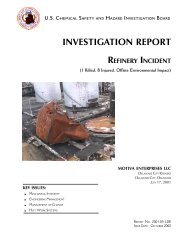CTA Report, Draft 1, ISP Review - US Chemical Safety and Hazard ...
CTA Report, Draft 1, ISP Review - US Chemical Safety and Hazard ...
CTA Report, Draft 1, ISP Review - US Chemical Safety and Hazard ...
You also want an ePaper? Increase the reach of your titles
YUMPU automatically turns print PDFs into web optimized ePapers that Google loves.
On February 20, 2003—the day of the explosion—<strong>CTA</strong> was scheduled to begin installing new makeup<br />
air units on lines 403 <strong>and</strong> 405.<br />
5.1.2 Line 405 Oven Temperature Controller<br />
Interviews with operators on line 405 <strong>and</strong> maintenance personnel, <strong>and</strong> a review of shift production logs<br />
revealed problems with the temperature controller for the curing oven as far back as December 20, 2002;<br />
the oven was running too hot. Production log entries noted that maintenance personnel had attempted to<br />
fix the controller on five occasions since December 2002.<br />
Four days prior to the explosion, the temperature controller was no longer regulating the oven temperature<br />
so controls were switched to manual by the line operators. The oven temperature was then controlled by<br />
opening <strong>and</strong> closing the access doors on the east <strong>and</strong> west sides of the oven. Since there was no spare<br />
controller available in the maintenance shop, an order for a new controller was placed with a supplier.<br />
5.1.3 Line 405 Baghouse<br />
<strong>CTA</strong> initially planned to replace the line 405 baghouse in 1996-97. Minutes from a December 1996 staff<br />
meeting indicate that two baghouse manufacturers were prepared to bid on the project. However, <strong>CTA</strong><br />
management opted not to fund the replacement of the baghouse at that time. A new cylindrical dust<br />
collector was erected in 2002 on a free-st<strong>and</strong>ing structure along the south wall of the facility to replace<br />
both the line 403 <strong>and</strong> 405 baghouses, but at the time of the explosion, it was not operational because new<br />
piping still needed to be connected.<br />
A few days prior to the explosion, line 405 operators were having problems with clogged bags in the<br />
baghouse. Operator statements <strong>and</strong> notations on shift production logs show that the baghouse was<br />
running at a high differential pressure, which indicated the bags were clogged. To unclog them, the bags<br />
had to be shaken repeatedly each shift. Operators also manually beat the bags with sticks during the line<br />
cleaning to remove the dust. They attributed the clogging problem to two causes:<br />
32









